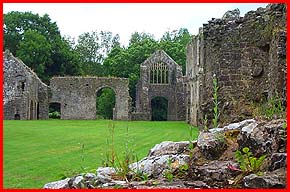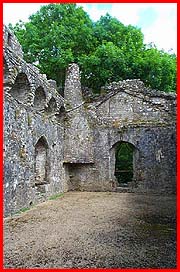Ilkeston Cam On Holiday 2001 - South West Wales - Part
02
Sunday Afternoon - Pembroke & The Bishop's
Palace, Lamphey
All the photos on this page were taken in July 2001

Following our brief look around Tenby and anxious
to see what else our holiday destination had to offer, we continued
westwards along the coast towards Pembroke. There are eleven
areas of outstanding natural beauty in England and Wales that
have been designated National Parks. We live near one of them,
the Peak District and have visited several others but this was
the first time we had seen the Pembrokeshire Coast National Park.
These two views of Manorbier Bay are prime examples of why the
area has earned this coveted status.
 
We soon reached Pembroke and parked close to its impressive castle.
Our first priority was lunch and a picnic beneath the castle
walls sitting by the river provided a pleasant interlude in a
busy day.

|
There are a variety of architectural styles within
a few hundred yards in Pembroke. As well as the massive structure
of the largest fortress in the area noted for being the birthplace
of Henry Tudor, there are old cottages built on solid rock foundations
opposite the castle that are but a stone's throw away from the
modernistic extension built alongside the Parish Church.
 
Here in Pembroke too, as in Tenby, there was evidence that the
locals had been busy with those pots of brightly coloured paints.

|
Being Sunday, Pembroke was a quiet town and wanting
to leave something for another day, we decided to wend our way
homewards and head back towards Saundersfoot via an inland route
along the higher ground a little inland from the coast known
as "The Ridge Way". On our way into Pembroke we had
seen a sign for "The Bishop's Palace" at Lamphey and
on an impulse, on our return journey, I turned down the lane
that led to it. Of such impulses are memories made.
 
|
Armed with portable battery operated audio guides
that not only pointed out the most interesting parts of the palace
but also included a soundtrack that with a little imagination
took you back to the early 14th century, we spent a delightful
couple of hours wandering through the ruins of the palace.


|
In its heyday, the palace at Lamphey became a favourite
residence of the bishops of St David's who as the brochure tells
us "were worldly men who enjoyed the privileges of wealth,
power and status". It was quite easy with the aid of the
soundtrack to picture the ruins of the Great Hall in all their
glory with a roof overhead and a second floor where all that
now remains of the great beams that supported it are holes in
the stonework.
 

|
Although established in the 13th century, the chapel
that still displays a fine five-light east window was a 16th
century addition to the palace.

|
Bathed in glorious sunshine I must admit I was in
my element clambering over the ruins and taking photos by the
score.
 The Great Hall The Great Hall
It is still possible to make out the original mediaeval artwork
at the top of this window opening.

As we prepared to leave, evidence of the mild climate
in this part of Wales could be seen in the vegetation beside
the palace walls (above left). Much of the work on Lamphey's
Bishop's Palace is attributed to Henry de Gower, Bishop of St
David's from 1328 to 1347. Henry was also responsible for another
palace that stands alongside the Cathedral in the small city
of St David's and that was to be our destination on Monday but
for now it was time to return to Saundersfoot.
|

